
Dynamic Garden in Full Motion
Saturday, July 28th until Sunday, September 9th, 2018
SUZUKI Motomasa

Photo: KATO Ken
Sculpture as Wedge
MURAKAMI Aya
Looking at SUZUKI Motomasa’s Living Dead (ACAC edition), the viewer experiences a feeling of moving in and out of reality. Unlike the many movies, television shows, video games, and other visual entertainment that merely draws your attention into a fictitious world, Living Dead (ACAC edition) fully engages the imagination while, at the same time, leaves the viewer mindful of their physical body.
Confronting the artwork, we see a grassy front lawn with stairs that lead to the front door of a wooden house with a chimney. The imagination swells with images of a family gathered inside around the fireplace. The artwork’s delicate modeling ignites the imagination and elicits memories of home, drawing us in as we imagine what the house is made of and what its surroundings must be like. Just as our imagination starts to take over, we are pulled back by the reality that exists in the artist's handiwork, his presence clearly sensed on the surface of his sculpture. No sooner does our immersion into the world of imagination begin than does the physical presence of the sculpture—it’s mass, texture, and smell—stop us from absorbing ourselves fully. When looking at the lawn, the imaginary smell of the grass competes with the actual smell of the clay. Peering through a window into the house, we see a black surface with clear vestiges of the artist's spatula, which tells us once more that this is, in fact, a sculpture. Living Dead (ACAC edition) confronts us with the fact that we exist within a body, and that even if our consciousness can immerse itself in a fictitious world, our physical body cannot.
Suzuki makes sculptural works based on personally significant scenes from movies and video games and images found on the Internet. He calls his productions “works of verification”—meaning he will take imagery that he finds attractive from those fictional worlds and then verify that it can exist as a three-dimensional object. Living Dead (ACAC edition) is related to Suzuki's Ghost series of lightboxes that follows the technique of a previous wooden model series in which Suzuki uses his imagination to fill in shapes that aren't visible in the original image. Suzuki first creates a relief with black oil-based clay, which he then photographs and frames in a lightbox. Suzuki’s lightboxes remove the model’s physicality, visualizing its shape and tactile form in order to solve the issues of storage and transportation that are inherent in sculpture. Suzuki has also explained that the reliefs are merely intended as subjects for his photographs and have no life of their own as sculptures. (*1) The clay model is only crafted in the name of the final two-dimensional production, and after being photographed, it is disassembled and returned to clay. His models are mere ghosts, never having been given life as sculpture, as they are born of imagery and return to imagery in the shape of a photograph.
With Living Dead (ACAC edition), however, Suzuki deviates from this cycle. Here, the clay model can be seen from all sides, and since the viewer’s vantage point is not fixed, Suzuki forwent the colored clay used in the windows of previous works to instead create a stark black sculpture. Lit from the side, the model is rid of the shadows and textures usually seen in sculpture. This serves to emphasize that the model exists in a flat, fictional world, yet the textures that glimmer in gaps in the light tell of its sculptural presence. A relief is by definition attached to the world in which it is created, its existence as a sculpture devoid of independence, but Suzuki gives new life to Living Dead (ACAC edition), which stands independent of its original context.(*2) The unnatural lighting serves to obscure the viewer’s vision, seemingly preventing them from viewing it as a normal sculpture.
Living Dead (ACAC edition) warns us that is utterly indifferent to scrutiny, while at the same time, it may be our own laziness that allows us to heed such a warning in the first place. Suzuki says that for him, this “work of verification” is a necessary process that allows him to give physical shape to objects from film and the internet in order to perceive and understand them. (*3) Certainly, as we are now surrounded by screens and constantly bombarded with information, we are wont to believe the images we see without really knowing if what we are seeing can actually exist. Ironically, it is a sculpture derived from a picture on a screen that alerts me to this laziness.
Living Dead (ACAC edition) will not allow us to immerse ourselves in it. As imagination and memory subside and the viewer is drawn back to their physical location in front of the sculpture, they are made aware of their senses and are left to accept the fact that their body certainly exists on the side of reality, not of fiction. I am reminded that sculpture drives the wedge needed to reclaim our physical bodies as we move in and out of reality.
(*1) Excerpt from an interview with the artist on September 9, 2018.
(*2) Toya, Shigeo, Uraka Hijikata, and Yōko Mori. Toya Shigeo Chōkoku to Kotoba: 1974-2013 (Nagaizumichō [Shizuoka-ken]: Vanjichō Kokuteien Bijutsukan, 2014), 85.
Yoshimoto, Takaaki. "Chōkoku No Wakaranasa." In Yoshimoto Takaaki Zenchosakushū, 335. Vol. 8. Tokyo: Keisōshobō, 1986.
(*3) Excerpt from an interview with the artist on September 9, 2018. Also in AC2 Vol. 20, Aomori Contemporary Art Centre, 2018.
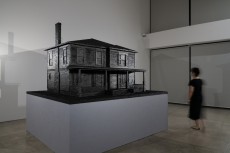
Living Dead (ACAC edition)
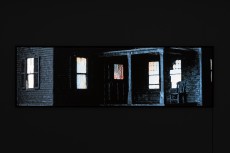
Ghost#1
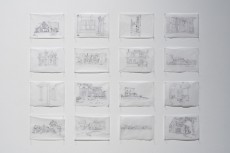
Drawing 16 pieces
未完の庭、満ちる動き
2018年7月28日(土)-9月9日(日)10:00 18:00、会期中無休、無料
鈴木 基真
SUZUKI Motomasa
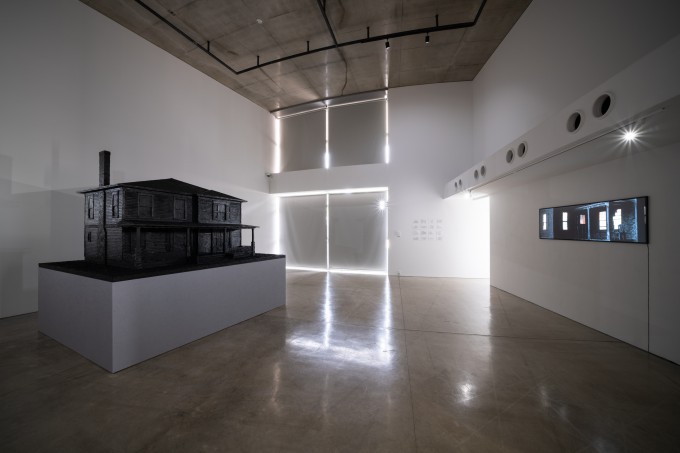
撮影:加藤健
楔としての彫刻
村上 綾
《生ける屍》を見るとき、現実と非現実を行き来する感覚を覚える。それは、映画やテレビ、ゲームといった多くの視覚的娯楽が身体抜きに架空の世界へ引き込むのとは異なり、想像に没頭しながらも身体を意識させ続ける。
作品を前にすると、木でできた家の正面の階段の手前は芝で覆われていて煙突があることから、中では暖炉を囲んで団らんが行われているのだろうと想像が膨らむ。繊細な造形は私たちの記憶の知覚を呼び起こして建材や家の周りの環境を想像させ、家にまつわる記憶や想像を引き出すのである。そのように没入しようとした矢先、彫刻の表面は作者の手の存在を明らかに伝えていることに気がつき、現実の世界に引き戻される。想像の世界に没入し始めると同時に彫刻の量感・表面の質感・匂いといった実際の存在に完全なる没入を阻まれる。芝生の部分を見つめるとき、想像上の緑の匂いと実際に感じている油粘土の匂いが拮抗する。奥はどんな様子だろうという思いで窓を覗くと、黒い表面によって視線は跳ね返され、明らかなヘラの跡はそれが彫刻であることを突きつける。《生ける屍》は私たちが身体をもって存在すること、架空の世界へ意識を没入させることは出来ても、身体を侵入させることは出来ないと自覚させるのである。
鈴木は映画やゲームなどの印象に残ったシーンやインターネット上の画像を基に彫刻作品を作る。彼は自身の彫刻制作を「確認作業」であると語り、自分自身が魅力的だと思った形を架空の世界にある形でさえ存在できることを立体に起こしながら確認する。ACACで発表した《生ける屍》と関連を持つゴーストシリーズでは、木彫のシリーズで画面からは見えない部分は想像で補いながら全体像を制作する作業を繰り返すうちに彼自身の頭に浮かんでくる形を拾い集めて構想される。このシリーズで行う工程は、黒の油粘土で半立体の塑像を作成し、写真撮影をしてライトボックスに仕立てるというものだ。鈴木は、イメージを形に変え、その形態と触覚的な造形の痕跡が視覚化され残るよう意図しつつ、保管や運搬の問題を超えるために写真作品を制作してきた。また、鈴木にとって被写体となる半立体の作品は彫刻としての命はないという(*1)。制作される塑像はあくまで平面の完成形のためのもので撮影が終われば解体され粘土に戻る。浮遊したイメージから作られる彫刻としての生を受けないイメージの集積は亡霊のままイメージへと戻っていくのである。
しかし、ACACで制作・発表した《生ける屍》は、そのサイクルを脱した存在になった。塑像は全方位から見ることが出来る配置となり、鑑賞者の視点が固定されないことから、以前の同シリーズでの作品の窓部分に入っていた色粘土も姿を消し黒一色の塑像が現れた。横方向から当てられた照明は相殺し合い影を最小限にして彫刻が見せるはずの凹凸を打ち消し、本来は平面の架空の存在であることを強調するが、光の隙間からのぞく彫刻の肌理は、その存在を隠せない。半立体(レリーフ)=世界の内側とつながった存在は、独立した存在としての彫刻(*2)へと息を吹き返したのである。先に述べた不自然な照明は、よく見ようとすれば強い光が目に入ってくるため、今まで通りの「彫刻」として見ることを拒むようだ。
《生ける屍》は見られることに関して不熱心な彫刻への警鐘を鳴らすと同時に、その警鐘を見ることに怠惰な私たちにも向けているのではないだろうか。鈴木にとって確認作業は、インターネットや映画の中にあるものを実在のものとして自身の感覚に取り込んで消化するために必要な作業であるという(*3)。確かに、日々スクリーンに囲まれ情報にまみれる現代において、私たちは画像をときに信じ込み、そこに映るものが存在しうるのかを本当は知らない。その怠惰さを皮肉にもスクリーンの中の画像から派生してきたイメージから作りだした彫刻によって思い知らされるのである。
そして《生ける屍》は没頭を私たちに許してくれない。引き起こされる想像や記憶に浸りながらも彫刻の目の前に引き戻されるとき、自らの知覚を意識させられ、身体が虚構の側ではなく現実の側に確かに存在することを確認している。彫刻が現実と非現実を行き来する私たちの身体を取り戻す楔となることを思い出させるのである。
(*1)インタビュー(2018年9月9日)での発言より。
(*2)戸谷成雄『彫刻と言葉1974-2013』ヴァンジ彫刻美術館、2014年、p.85
吉本隆明「彫刻のわからなさ」(『吉本隆明全著作集:8』勁草書房、1986年、p.335)
(*3)インタビュー(2018年9月9日)での発言より。『AC2』20号、国際芸術センター青森、2018年
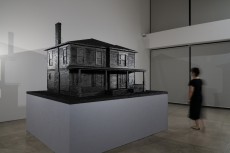
《Living Dead (ACAC edition)》
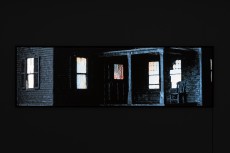
《Ghost#1》

ドローイング16点
